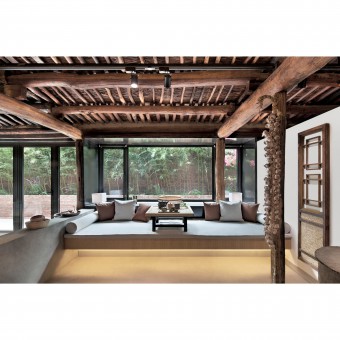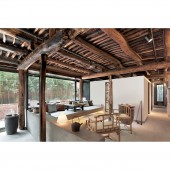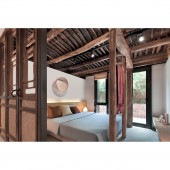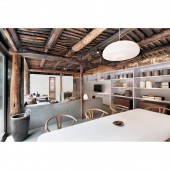Reborn From Ruins Residential House by Lei Jin, Tianqi Guan and Teng Guo |
Home > Winners > #58315 |
 |
|
||||
| DESIGN DETAILS | |||||
| DESIGN NAME: Reborn From Ruins PRIMARY FUNCTION: Residential House INSPIRATION: The project is situated in ChangGe Village, Daxing County, in southwestern suburb of Beijing. The place had no water supply nor a restroom– its residents, a senior farm couple, needed to walk out 100 meters around the house to get to the closest loo in the neighborhood. The house's long but narrow courtyard facing south functioned as a pathway for the family's only transport vehicle, a three-wheeler, which was inconveniently parked in a dead end. Even worse, interior floor elevation of the house was almost 20 centimeters lower than the courtyard, turning the house into a flooding pond whenever it rained, a safety threat to the entire building structure. Ironically, the area was troubled by water shortage – water gets cut off almost daily, sometimes during peak evening hours. UNIQUE PROPERTIES / PROJECT DESCRIPTION: The remodel project was one episode of BTV's live television show series called “Our Warm New Houses”, newly rolled out earlier this year. The show producer set up specific but stringent requirements on cost and construction speed. Design and construction needs to be completed in 45 days. All-inclusive budget is capped at 300,000 RMB (about 45,000 USD), including labors and materials on field work, site remodeling, interior construction, lights and fixtures, furniture and interior decorations, even purchasing new home electronics. OPERATION / FLOW / INTERACTION: In terms of functional layout, we have made adjustments to re-organize the floorplan based on detailed communications with the residents, understanding their daily routines and habits. Outside the house, we first re-located the parking area of the “three-wheeler”, from the inner-most end of the courtyard to outside of the gate, so the courtyard could be fully utilized, and not having to worry about its pathway function. We then planted bamboos & lavenders along the neighboring wall by the south side of the courtyard facing the house, creating a relaxing and serene landscape to be viewed from inside. PROJECT DURATION AND LOCATION: Design Phase: May 2015/ Project Complete: July 2015 FITS BEST INTO CATEGORY: Architecture, Building and Structure Design |
PRODUCTION / REALIZATION TECHNOLOGY: Inside the house, by custom, the locals particularly dislike windows on the north wall, so we have carefully accommodated this by moving all the storage function to the north side of the house, while taking the daily activity function to the south side where it is also better lit. As the house layout takes the shape of a narrow rectangle, with the long side oriented north and south, the middle part of the house is better suited as a common area. It also separates the resting areas for hosts and guests, allowing for better privacy. After elevated the floor for flood control, the building height is only 2.1 meters. So we removed the suspended ceiling, to allow for more space. Then, after some cleaning and maintenance work, the original wood structure and straw-covered ceiling texture is finally revealed, telling a story of time. SPECIFICATIONS / TECHNICAL PROPERTIES: Site Area: 210 square meters/ Total Floor Area: 130 square meters TAGS: renovation, redevelop, low cost, low budget, village, brick house, wood RESEARCH ABSTRACT: Originally, one side of seven structural columns were partially exposed to the exterior, which could potentially become a safety issue given their age. We have managed to push out the south side exterior wall by 50 centimeters, so the columns are now behind the wall, protected against wind and rain; a source of natural beauty, these wood columns themselves seamlessly become part of interior decorations. During site survey process, we discovered a narrow pathway about 80 centimeters wide between the west side of the building and neighboring wall. So we designed a view window at the end of the corridor toward the west side. Outside the window, swinging bamboo shadow helps to connect the interior space with the natural environment. CHALLENGE: To solve the core water issue, our architectural design process thoroughly considered the challenges of both water shortage and flood control. First, we elevated the interior floor, adjusted exterior courtyard ground level and installed new sewer and gutter systems. In addition, a new water tank with a capacity over 2-cubic-meters was built at one end of the courtyard, to harvest and recycle rain water collected from the rooftops. In the evenings when water gets occasionally cut off, collected rain water could be used as a supplementary water source for toilet flushing or to satisfy other essential needs, for up to a year. At the same time, with water drainage now in place, the building structure stands strong even in pouring rain. ADDED DATE: 2017-06-14 05:54:54 TEAM MEMBERS (2) : Lei Jin, Tianqi Guan and Teng Guo and IMAGE CREDITS: Xiazhi |
||||
| Visit the following page to learn more: http://www.evolutiondesign.com.cn/casein |
|||||
| AWARD DETAILS | |
 |
Reborn From Ruins Residential House by Lei Jin, Tianqi Guan and Teng Guo is Winner in Interior Space and Exhibition Design Category, 2017 - 2018.· Read the interview with designer Lei Jin, Tianqi Guan and Teng Guo for design Reborn From Ruins here.· Press Members: Login or Register to request an exclusive interview with Lei Jin, Tianqi Guan and Teng Guo. · Click here to register inorder to view the profile and other works by Lei Jin, Tianqi Guan and Teng Guo. |
| SOCIAL |
| + Add to Likes / Favorites | Send to My Email | Comment | Testimonials | View Press-Release | Press Kit |
Did you like Lei Jin, Tianqi Guan and Teng Guo's Interior Design?
You will most likely enjoy other award winning interior design as well.
Click here to view more Award Winning Interior Design.








